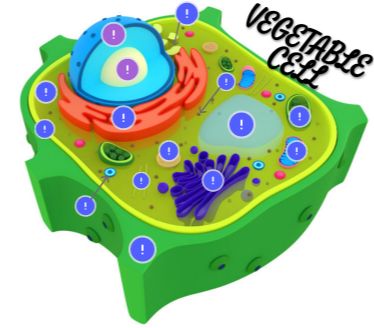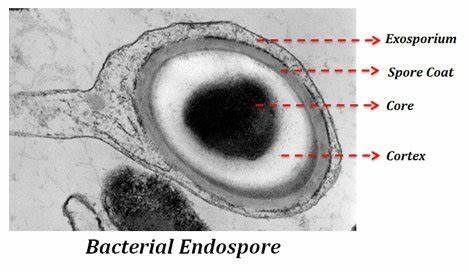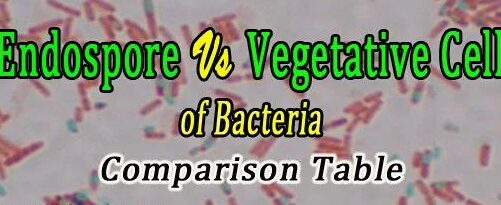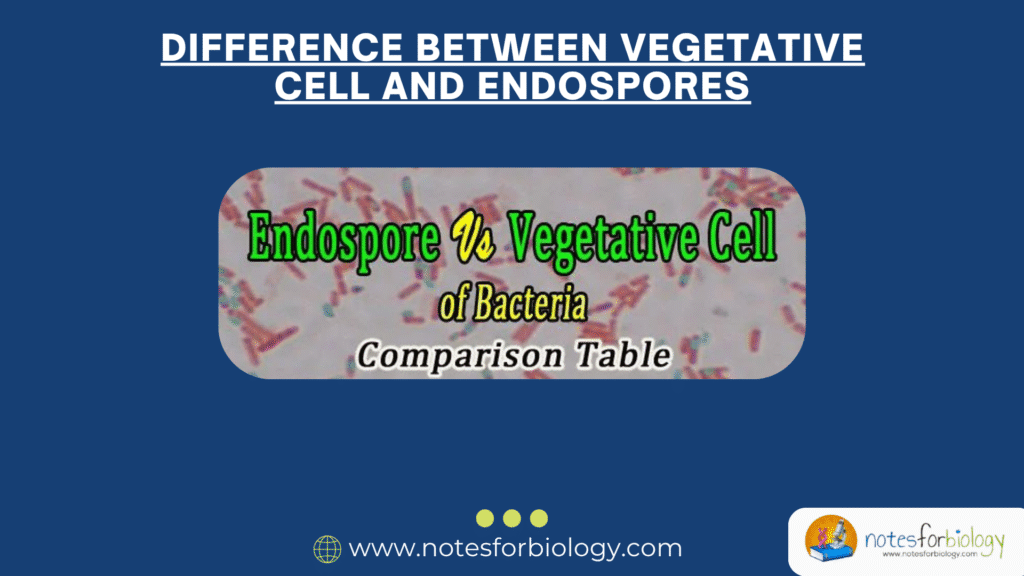Introduction
Vegetative cell and endospore are two different forms of a bacterial cell, where the vegetative cell is the active, growing form and the endospore is the dormant, highly resistant form that helps the bacterium survive harsh conditions. Bacteria are fascinating microorganisms that can survive in some of the harshest environments on Earth. One of the reasons they are so tough is their ability to switch between two different forms the vegetative cell and endospores.
These two forms are very different in structure, function, and purpose. A vegetative cell is the normal, active, growing form of a bacterium. An endospore, on the other hand, is a tough, protective, non-living form that helps the bacterium survive when conditions are dangerous or unfavorable.
Summary of Vegetative Cell and Endospores
- Vegetative cells are the active, living form of bacteria that grow, reproduce, and perform normal metabolic functions but are sensitive to heat, chemicals, and harsh environments.
- Endospores are dormant, highly resistant structures formed by some bacteria to survive extreme conditions like heat, dryness, and lack of nutrients.
- Bacteria switch from vegetative cells to endospores through a process called sporulation and return to vegetative form when conditions become favorable again.
Table of Contents
What is a Vegetative Cell?

A vegetative cell is the regular, active form of a bacterial cell. It is what we usually see when we grow bacteria in the lab on a culture plate or in a broth. These cells are soft, sensitive, and busy doing their normal life activities.
Characteristics of Vegetative Cells:
- Active: They are growing, multiplying, and performing normal life functions like eating and releasing waste.
- Reproductive: Vegetative cells reproduce by binary fission — a simple form of asexual reproduction.
- Metabolically Active: They consume nutrients, produce energy, and respond to their environment.
- Short-Lived in Harsh Conditions: They can die easily if the environment becomes too hot, dry, acidic, or if there are harmful chemicals.
Structure of Vegetative Cells:
- Have a cell wall and plasma membrane.
- Contain cytoplasm, ribosomes, and DNA.
- Lack any tough outer coating or special survival structures.
- May have flagella or pili to move or attach to surfaces.
In short, vegetative cells are the “everyday” working form of bacteria — they are busy and alive but vulnerable.
What is an Endospore?

An endospore is a special, dormant (inactive) structure formed by some bacteria when conditions become too harsh for survival. It’s like a safety capsule that protects the DNA and essential parts of the cell.
Only certain types of bacteria, especially Gram-positive bacteria like Bacillus and Clostridium, can form endospores. They do this when they run out of nutrients, get too hot or dry, or face other threats.
Characteristics of Endospores:
- Dormant: Not growing, eating, or multiplying — just staying alive in “sleep mode.”
- Extremely Resistant: Can survive boiling, radiation, drying, freezing, and strong chemicals.
- Long-Lived: Some endospores can survive for hundreds or even thousands of years!
- Germinates When Safe: When conditions improve, the endospore can turn back into a vegetative cell.
Structure of Endospores:
- Have multiple protective layers, including a tough outer coat made of keratin-like proteins.
- Contain very little water, which helps them resist heat and drying.
- Contain calcium and dipicolinic acid, which protect the DNA and enzymes inside.
- Have no metabolic activity during dormancy.
Key Differences Between Vegetative Cell and Endospores

Here is a simple comparison of the two Vegetative Cell and Endospores
| Feature | Vegetative Cell | Endospore |
|---|---|---|
| State | Active and living | Dormant (inactive) |
| Function | Growth, reproduction, metabolism | Survival during harsh conditions |
| Reproduction | Can reproduce (binary fission) | Cannot reproduce |
| Resistance | Sensitive to heat, chemicals, drying, etc. | Extremely resistant to heat, radiation, chemicals |
| Water Content | High | Very low |
| Metabolic Activity | High (active metabolism) | No metabolism |
| Structure | Simple with soft cell wall | Complex with thick, protective layers |
| Life Span | Short if exposed to unfavorable conditions | Can survive for centuries |
| Examples | E. coli, Salmonella, Staphylococcus | Bacillus subtilis, Clostridium botulinum |
Key Differences Between Vegetative Cell and Endospores
- Vegetative Cell and Endospores are forms of the same bacterial organism, representing different life stages.
- Vegetative Cell and Endospores contain the bacterial DNA and essential cellular components.
- Vegetative Cell and Endospores play important roles in the survival and life cycle of bacteria.
Why Do Bacteria Form Endospores?
Bacteria form endospores to protect themselves when the environment becomes life-threatening. This process is called sporulation, and it happens when:
- There are no more nutrients.
- The temperature is too high or too low.
- There is no water (drying out).
- There are harmful chemicals or radiation.
- The pH becomes too acidic or too basic.
By forming an endospore, the bacterium ensures that its genetic material stays safe until better conditions return. It’s like going into hibernation during a storm.
How Does a Bacterium Form an Endospore?
The process of endospore formation is complex and happens in several steps:
- DNA Replication: The bacterium copies its DNA.
- Spore Septum Forms: A small part of the DNA and cytoplasm is separated from the rest of the cell.
- Forespore Development: The smaller section becomes the future endospore.
- Cortex Formation: Protective layers form around the forespore.
- Spore Coat Forms: A tough, outer coating develops.
- Maturation: The spore becomes fully developed and strong.
- Release: The rest of the cell breaks down, and the endospore is released.
This whole process takes several hours but gives the bacterium a chance to survive for years.
How Do Endospores Return to Vegetative Cells?
When the environment becomes friendly again (with food, water, and warmth), the endospore can germinate, meaning it “wakes up” and becomes a normal, active vegetative cell again.
This process happens in three stages:
- Activation: The spore senses a better environment.
- Germination: The protective layers break down.
- Outgrowth: The bacterial cell grows out of the spore and starts dividing.
Importance in Health and Disease

Endospores are very important in medicine and public health because they are hard to kill and can cause serious diseases. For example:
- Clostridium botulinum: Causes botulism, a deadly form of food poisoning.
- Clostridium tetani: Causes tetanus.
- Bacillus anthracis: Causes anthrax, a dangerous infection used in bioterrorism.
These bacteria form spores that can survive in the soil, dust, or food for years and become active when they enter the human body.
This is why sterilization and proper food handling are so important. Simple boiling or cleaning may not destroy spores; special methods like autoclaving (steam under pressure) are needed.
Importance in Industry and Research

Endospores are also studied in labs and used in testing sterilization equipment. If a machine can kill spores, it can kill almost any microorganism.
In biotechnology, scientists are exploring ways to use spore-forming bacteria in vaccines, probiotics, and environmental cleanup because they are so tough and adaptable.
Conclusion
Vegetative cell and endospores represent two different survival strategies in bacteria. The vegetative cell is the normal, active form, busy with growth and reproduction. The endospore is a survival capsule, built when life becomes too difficult.
These two forms show just how smart and adaptable bacteria can be switching from soft and vulnerable to tough and nearly indestructible. Understanding this difference helps us better control infections, improve sterilization, and use bacteria safely in science and industry.
FREQUENTLY ASKED QUESTION
What are vegetative cell and endospores ?
Endospores are tough, dormant structures formed by some bacteria to survive harsh conditions like heat, dryness, and lack of nutrients.
Vegetative cells are the normal, active form of bacteria that grow, reproduce, and carry out metabolism in favorable environments.
What is the difference between vegetative cells and endospores ?
The difference between vegetative cells and endospores is that vegetative cells are active and growing, while endospores are dormant, highly resistant structures formed to survive harsh conditions.
What are the similarities of vegetative cell and endospores ?
The similarity between vegetative cells and endospores is that both contain the bacterial DNA and are forms of the same organism, serving different roles in the bacterial life cycle.
Related Articles




